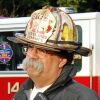Chief Goldfeder looks back on 2007 – and what is hopefully the start of a welcome new trend.
FireFighterCloseCalls.com
I seem to have a reputation of being a pessimist, who only talks about or delivers bad news. Well, someone else can deliver good news — I want us to stay focused on the preventable problems, and that’s usually bad news.
But I am starting to see a turnaround in one area — apparatus accidents. People may say we are still seeing 100 or so line-of-duty deaths every year, and 2008 is no different. But anybody who feels we are going to eliminate them all is being unrealistic.
It’s a dangerous job and bad things are going to happen sometimes — that’s the nature of this job — but it’s the avoidable injury and death we need to stay focused on.
But what I have started to see this year is a glimmer of hope specifically related to vehicle accidents. We have seen apparatus crashes this year with different results than in past years. We have seen more use of seat belts, and this is a positive issue that I want to stress.
Tip O’Neill once said ‘All politics is local.’ And I think this is something that can be applied to the fire service — that all solutions are local.
All the various national fire service initiatives, programs and tools are already out there — and available. I am not sure much more can be provided. Now it’s up to the fire chiefs and officers to decide whether they are going to apply these to their departments — and it is up to firefighters to decide to follow their training and their policies.
And this is something that’s starting to happen. I’m fortunate to get to travel throughout North America and I’m seeing this for myself. More firefighters are developing a greater understanding of their department’s policies and procedures and taking training more seriously because they don’t want to unnecessarily get hurt.
This isn’t across the board — and there are still some departments where that’s not the case — but for the most part I am starting to see some significant change.
It’s still the case that more than 50 percent of line-of-duty deaths are being caused by heart attacks or strokes. And for those who fail to take an annual physical, and who don’t exercise or eat right, then there’s not much more we can do to help.
That brings us on to the second major cause of line-of-duty deaths, vehicle accidents, which is something we have a lot more control over. This year, it seems to be the case that firefighters are starting to understand that they can do no good if they don’t arrive on the scene in the first place.


